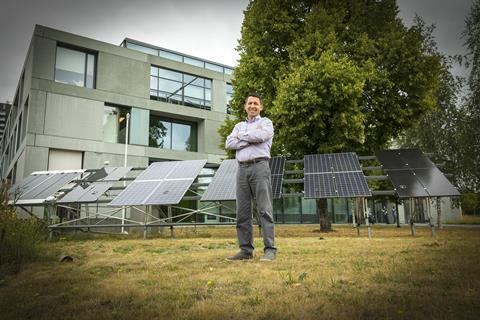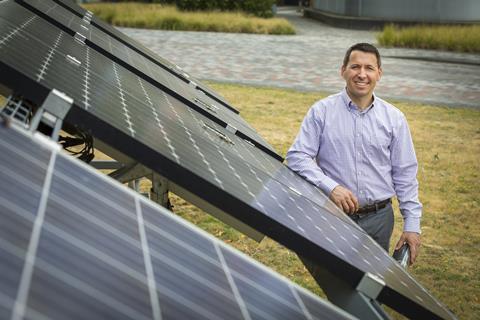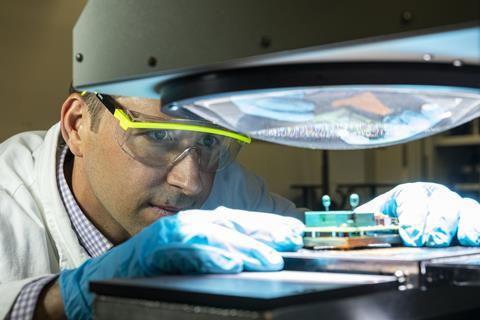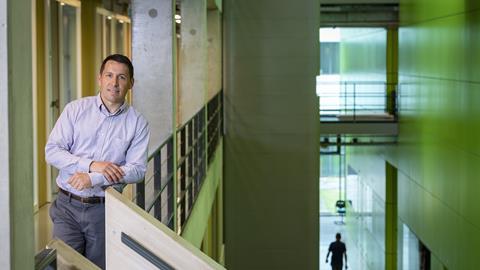Erik Garnett is the 2022 recipient of the KNCV Gold Medal. His research centers around light as the driver of chemical reactions. ‘This could open up a whole new way of producing the molecules we need.’
Finally, Erik Garnett can talk. This summer, he got a call from Yvonne van der Meer, chair of the KNCV, that he was awarded the KNCV Gold Medal 2022 for this groundbreaking, cross-disciplinary research that combines nanomaterials, photochemistry, materials chemistry and nanophotonics. In addition, the jury sees Garnett, who is group leader at AMOLF and professor of nanoscale photovoltaics at the University of Amsterdam, as an inspiring mentor and an active communication with strong international visibility. A great ambassador for Dutch chemistry, according to the jury. But because the formal announcement was planned during chemistry conference CHAINS in September, it had to stay secret. ‘It was really hard, when you get such exciting news and you can’t tell anyone.’
It is a cliché question to start with, but what is the essence of your research?
‘There are two main lines and both are focused on light. One research line is about photovoltaics; making solar cells more efficient and stable. The other main topic is using light to control chemical reactions and that can be molecular reactions, but also solid state reactions.’
‘Light allows you to determine what takes place where and when’
Why this central role for light in your work?
‘Well, you know that energy is needed to drive chemical reactions and traditionally we use heat to put energy into the system, but heat is very non-specific. Everything just heats up. It is very hard to control heat, both in space and time and that also means that you have less control of where and when the energy is ‘injected’. But light enables very specific control of energy. You can use specific wavelengths that only affect the chemicals bonds or molecules or reactions of your choice. Basically, light allows you to determine what takes place where and when.’
Let’s assume we manage to do that, what will it enable us to do that we can’t do now?
‘We know that we can control the product by shifting the wavelength; a slightly different ‘color’ results in a very different product. The system can take a different pathway depending on the light you use. So, that may enable the design of a reactor where different reactions and processes can take place and you can decide which product will be delivered just by pulsing light at different frequencies. No need to change the whole set-up and change all the ingredients. It all stays there and you just change the light.’

‘My long-term dream is that we are able to guide and accompany a molecule through a whole series of transformations by just pulsing light in the system. In a way, there is an analogy with biological pathways. In biology, you see that a molecule is accompanied by all kinds of proteins, most notably the chaperones, to undergo a range of conversions. Depending on the enzymes, one pathway is selected or another. And that is an extremely fascinating concept. If we can imitate that, it would mean a whole new way of producing the molecules we need.’
You started by saying that you aim to use light instead of heat to drive reactions, but light does generate heat.
‘Yes, that is the other part of the story. One of our goals is to apply heating without burning fossil fuels. Of course, it is possible to power a conventional thermal reactor using electricity and resistive heating, but using light offers an alternative source of heat with several major advantages. As I said earlier, heating the whole reactor is very non-specific, but when we use light, we get precision heating. We can address where and when the system is heated. Light is very fast and very targeted and that creates the possibility of jumping between high and low temperature regimes. Because light is so targeted and specific, imagine heating up a certain part of a catalyst to enable reaction step 1, turn the light off, and then step 2 takes place. With light, you can create local conditions at active site that are very different from the bulk.’
‘We can predict where the light will go, but what we can’t predict is the chemistry that will take place’
‘Another example is the use of light to control binding and release of molecules to a catalyst. It can be difficult to find the right balance between binding strong enough to allow the reaction to take place and not too strong, because after conversion the product needs to be released. Light can target specific bonds, so we can opt for strong molecular binding to increase conversion rates and release the product by using a light pulse to break the right bonds.’
And to realize this new use of light you primarily work with plasmons, but those are still quite puzzling to me.
‘It is not that difficult, plasmons are easy to understand.’
Oh, really?
‘Yes, what plasmons do is they concentrate energy. They’re very similar to an antenna, that is why we also call them plasmonic antennas. An antenna picks up the right frequency from all the frequencies present and concentrates the radiation into a much smaller volume. It is tuned to only select that particular frequency. The same goes for plasmons. By using specific materials in a specific configuration, you can select a certain wavelength to be picked up and concentrated.’
How do you create a plasmonic antenna?
‘Using colloidal chemistry, we create metal nanocrystals, in our case gold nanocubes, that are placed on a gold mirror with a very thin layer of aluminum oxide in between. The size and the shape of the nanocubes are key in controlling the resonance and thus the wavelength of the incoming light that gets concentrated.’

And that, in turn, controls the chemistry?
’We used methylene blue, a well-studied model compound, as a ligand and we saw different types of chemical reactions taking place depending on the resonant frequency of the plasmonic antenna. By slightly changing the color of excitation light from bright red to dark red, we moved from the standard photochemistry, demethylation, to a selective light-driven desorption that hadn’t previously been observed. Now, we are building on this concept within an ARC CBBC project to make plasmonic antennas that can be used for CO2 reduction. The idea is to use our plasmonic nanoparticles plus light to create longer carbon chains starting from CO2. At this point, we have no idea which frequency we should use.’
‘Solar energy is what we need to go for. It is everywhere, there is no single nation that can claim it’
Is there a theoretical basis that you can work from?
‘We can predict where the light will go, but what we can’t predict is the chemistry that will take place. There is just too much that we don’t understand, for example when it comes to excited state dynamics. But to me, that is not a problem. I want to be at the place where we see exciting things happen that we don’t yet understand. The same goes for the heating component of our work. Superfast, local heating enables all kinds of interesting options. You can create a huge thermal gradient: two atoms in the same molecule could be 10K apart in temperature. That is a big difference and may allow for completely different reactions to take place within the same molecule. It would open up amazing possibilities and I really think we have a hint on how to get there.’
Why did you decide to work on this particular topic?
‘I have always been interested in solar energy, even when I was still very young. I used to read about solar cells a lot and I knew I want to do something in that field. When I was in high school [in the USA, ed.], there was a big hydrogen initiative in the US with lots of money being invested in fuel cells and I started looking at all the job openings of companies that work in this sector and they were all asking for chemists. So, I knew that I needed to study chemistry if I wanted to work on the sustainable energy transition. My supervisor in graduate school, Peidong Yang, worked on nanomaterials and single nanowire devices for energy applications and that is how I got into nanoscience. And as a postdoc at Stanford with Mark Brongersma, who actually got his PhD here at AMOLF, I was introduced to plasmonics and that put me on the path of using light to concentrate energy to drive chemical transformations.’

And why the move to the Netherlands, to AMOLF?
‘AMOLF had a position open that fit really well with my interests and background, so I applied.’
I ask because here, we have the tendency to look to the US as the place to be for science, with the best universities and the best groups.
‘Well, in my work materials science, chemistry and physics come together and in all these areas the Netherlands is very strong, which makes it a good place to be. Coming back to your point about the US, yes, there absolutely are top institutes and top groups, but overall I would say that life is much more difficult over there. Funding rates are really low and funding periods are very short. Too short to cover a PhD track with one grant like you can over here. The Netherlands does a good job in the way everything is organized and also the teaching burden is relatively low.’
[Seems to hesitate]
But…? What could be improved here?
‘What I like about the US is that people just do things. You have an idea and you try it out. Of course, many things fail, but when it does work out, you’re immediately ahead. That mentality really speeds things up. Here, the whole ‘polder’-thing is great, but it also takes a very long time. People are more risk averse, whereas in the US people are more comfortable with high-risk projects. When it doesn’t work out, it is not seen as a personal failure, because you did get something going, apparently you were able to convince others, attract some funding etc. And now you just have to try again. That is completely different here in the Netherlands.’
‘The whole ‘polder’-thing is great, but it also takes a very long time’
‘It would be good if we would become more active in starting new things. When you look at climate change or the chemical industry; you just can’t keep on talking forever. Don’t wait for full buy-in, because when you wait for consensus, you will be too late. The earth is a very complex system and there are tipping points. If we pass those, things will speed up to such an extent that we can’t turn back. The problem is that the world economy drives on growth, but we need to get to a steady-state, the point at which we have no need for new, raw materials because we can reuse everything we produced before again and again. Urban mining will be the new way to supply us with ‘raw’ materials.’
What do we need to do to get there?
‘Solar energy is what we need to go for. It is everywhere, there is no single nation that can claim it. But we need to double the efficiency of solar cells, that is the challenge on the energy supply side. The other challenge is to be able to reuse and recycle all materials at the end of their life.’

How does your research fit in here?
‘We are exploring the concept of material learning. We work on solar cells that become better at capturing energy because they ‘learn’ over time how to transform their internal structure to maximize efficiency. These solar cells are self-optimizing, just like flowers that turn towards the sun to catch as much light as they can.’
Moving on to another topic that is high on your list: diversity and inclusion. Why is that important to you?
‘Different reasons. There is the social justice component. We know that there are many historically underrepresented groups and I think we should make an effort to fix that and to really create equal opportunities for everyone. And there is also the performance component, because we are, for sure, missing out on talent if we stick to what we know. Increasing diversity simply means increasing the talent pool. Moreover, if you have a group of people who were all raised in a similar environment with a similar education and a similar background, the solutions they come up with will probably be similar as well. Different people bring different perspectives to a problem.’
‘It really annoys me to hear people say they looked for women, but couldn’t find them’
How can we promote diversity and inclusion, without it becoming just one more administrative chore with boxes to tick off?
‘The dominant idea is still that in science ‘we only select on quality’, but that is nonsense. How do you define quality? Also, we all tend to choose what is familiar to us. The argument that ‘we looked but we couldn’t find any women or minority groups’ is just absurd. If your group exclusively consists of white males, it may very well be that many people don’t feel comfortable applying. Having a more diverse team will stimulate higher diversity among your applicants.’

But what does that mean in practice? What do you do to actively create a diverse group?
‘Last year, we organized a symposium on strong coupling: changing the optical environment to change the chemistry. It is an upcoming theme in the field and we were looking for interesting speakers and it turned out that all the PI’s we could find were men. But when I scanned the seminal papers on this topic, many of the first authors, which were PhD students and postdocs, were women. So, we changed the approach and made a session where all the speakers were these women who are driving the field forward. This is a way to create your own talent pool; you have to actively tackle the subject. It really annoys me to hear people say they looked for women but couldn’t find them. Come on, be creative, we’re scientists after all.’













Nog geen opmerkingen